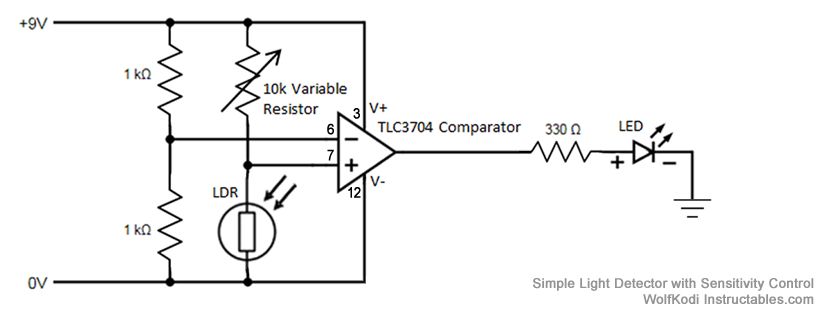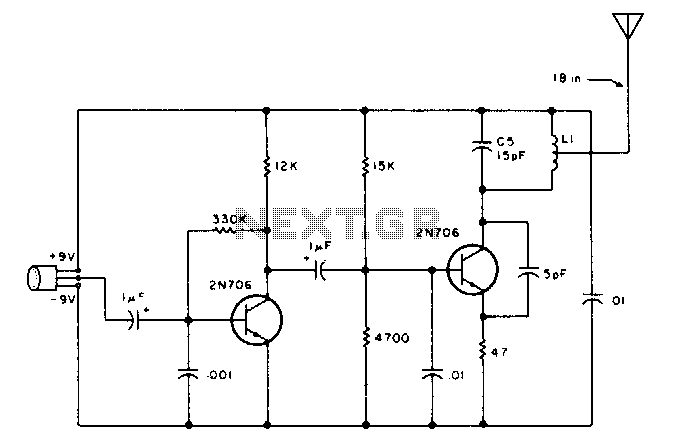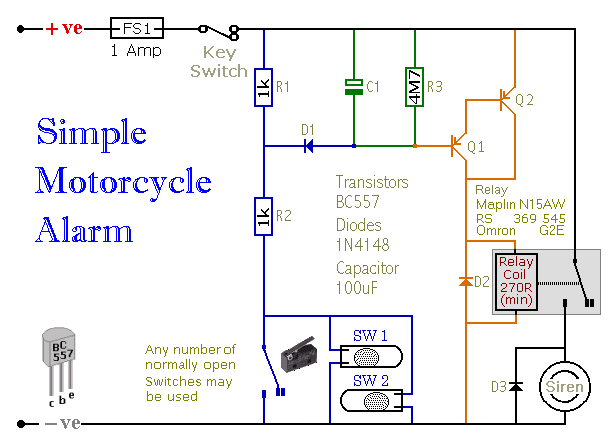
Simple Infra-Red Transmitter/reciever Shematics

This 1 channel infrared transmitter/receiver remote control is the cheapest and simplest you can find. The transmitter transmits a sequence of pulses on 36 KHz frequency carrier. The diodes are Schottky type because of their low voltage drop (only 0.2V). The ripple counter 74HC4060 contains an oscillator which controls the frequency carrier to be 36KHz. The current consumption of the transmitter with the button pressed is 6mA. The receiver is really simple without any coding/decoding stages. Of course in
The described circuit comprises a basic infrared (IR) transmitter and receiver system, designed for low-cost applications. The transmitter utilizes a 36 kHz carrier frequency, generated by a ripple counter IC, specifically the 74HC4060. This IC is equipped with an internal oscillator that allows for precise frequency generation, making it suitable for applications requiring stable transmission.
The transmitter circuit is powered by a suitable voltage source, and when activated by a button press, it draws a current of approximately 6 mA. The use of Schottky diodes in the circuit is advantageous due to their low forward voltage drop of 0.2V, which enhances efficiency by minimizing power loss during operation. This feature is particularly beneficial in battery-powered applications, where energy conservation is crucial.
The receiver module is designed to be straightforward, lacking complex coding or decoding stages. It typically consists of a photodiode or phototransistor that detects the infrared signals emitted by the transmitter. When the IR pulses are received, the receiver converts the optical signals back into electrical signals, which can then be used to control various devices or functions.
In summary, this infrared transmitter/receiver system offers a simple and cost-effective solution for remote control applications, making it suitable for hobbyist projects, basic remote controls, and other low-complexity systems. The use of standard components ensures ease of assembly and availability, contributing to its appeal in educational and prototype environments.This 1 channel infrared transmitter/receiver remote control is the cheapest and simplest you can find. The transmitter transmits a sequence of pulses on 36 KHz frequency carrier. The diodes are Schottky type because of their low voltage drop (only 0.2V). The ripple counter 74HC4060 contains an oscillator which controls the frequency carrier to be 36KHz. The current consumption of the transmitter with the button pressed is 6mA. The receiver is really simple without any coding/decoding stages. Of course in
The described circuit comprises a basic infrared (IR) transmitter and receiver system, designed for low-cost applications. The transmitter utilizes a 36 kHz carrier frequency, generated by a ripple counter IC, specifically the 74HC4060. This IC is equipped with an internal oscillator that allows for precise frequency generation, making it suitable for applications requiring stable transmission.
The transmitter circuit is powered by a suitable voltage source, and when activated by a button press, it draws a current of approximately 6 mA. The use of Schottky diodes in the circuit is advantageous due to their low forward voltage drop of 0.2V, which enhances efficiency by minimizing power loss during operation. This feature is particularly beneficial in battery-powered applications, where energy conservation is crucial.
The receiver module is designed to be straightforward, lacking complex coding or decoding stages. It typically consists of a photodiode or phototransistor that detects the infrared signals emitted by the transmitter. When the IR pulses are received, the receiver converts the optical signals back into electrical signals, which can then be used to control various devices or functions.
In summary, this infrared transmitter/receiver system offers a simple and cost-effective solution for remote control applications, making it suitable for hobbyist projects, basic remote controls, and other low-complexity systems. The use of standard components ensures ease of assembly and availability, contributing to its appeal in educational and prototype environments.This 1 channel infrared transmitter/receiver remote control is the cheapest and simplest you can find. The transmitter transmits a sequence of pulses on 36 KHz frequency carrier. The diodes are Schottky type because of their low voltage drop (only 0.2V). The ripple counter 74HC4060 contains an oscillator which controls the frequency carrier to be 36KHz. The current consumption of the transmitter with the button pressed is 6mA. The receiver is really simple without any coding/decoding stages. Of course in





